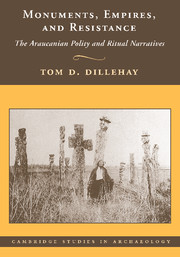Book contents
- Frontmatter
- Contents
- Figures
- Preface
- INTRODUCTION
- PART ONE PROSPECTS AND PATTERNS
- PART TWO ANALYSIS AND INTERPRETATION
- SEVEN CONTACT, FRAGMENTATION, AND RECRUITMENT AND THE REHUEKUEL
- EIGHT RECURSIVENESS, KINSHIP GEOGRAPHIES, AND POLITY
- NINE EPILOGUE
- Appendix One Ethnographic Ritual Narratives at Hualonkokuel and Trentrenkuel
- Appendix Two Radiocarbon Dates and Thermoluminescence Dates
- References Cited
- Index
EIGHT - RECURSIVENESS, KINSHIP GEOGRAPHIES, AND POLITY
Published online by Cambridge University Press: 27 July 2009
- Frontmatter
- Contents
- Figures
- Preface
- INTRODUCTION
- PART ONE PROSPECTS AND PATTERNS
- PART TWO ANALYSIS AND INTERPRETATION
- SEVEN CONTACT, FRAGMENTATION, AND RECRUITMENT AND THE REHUEKUEL
- EIGHT RECURSIVENESS, KINSHIP GEOGRAPHIES, AND POLITY
- NINE EPILOGUE
- Appendix One Ethnographic Ritual Narratives at Hualonkokuel and Trentrenkuel
- Appendix Two Radiocarbon Dates and Thermoluminescence Dates
- References Cited
- Index
Summary
This chapter is an interpretative continuation of several themes presented in the last chapter, but with emphasis given to the wider political policies and demographic settings that are materially manifested by kuel and rehuelkuel. This chapter also reflects on some of the conceptual approaches developed in Chapter 2. Specifically treated are identity, compatriotism, and memory, which are important to the transformative composition of the Araucanian polity.
I stated in Chapter 4 that the Araucanians perceive humans being embedded in a larger time–space or cosmic society whereby life cycles are circular with ancestors and the living constantly linked (see Faron 1964; Dillehay 2003) in a landscaped geography characterized by a network of mental images, visual sightings, and physical pathways that connect historical places, sacred spaces, and the kuel and rehuekuel with figures in the ethereal upper world. This network of ancient settings gave historical significance to the organization of ritually sanctified political alliances among the Araucanians in times of sporadic low-intensity warfare with the Spanish and later with the Chileans. In places like Purén and Lumaco, kuel were the architectural landmarks that served as the physical evidence of the movements, effects, and responses of increased contact between the Araucanians in late pre-Hispanic times and later with the Spanish in Purén and Lumaco and other areas. In this context, mounds and other sacred features represent an architectural ideology that formed the ceremonial landscape (Dillehay 1990c), which contributed to the vitality and integrity of the warring indigenous population.
- Type
- Chapter
- Information
- Monuments, Empires, and ResistanceThe Araucanian Polity and Ritual Narratives, pp. 370 - 397Publisher: Cambridge University PressPrint publication year: 2007



